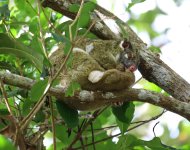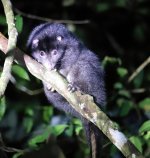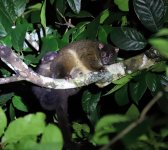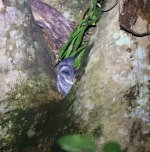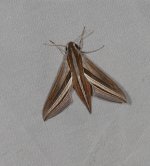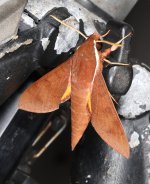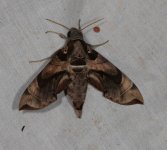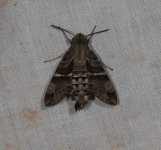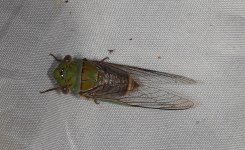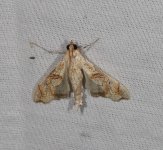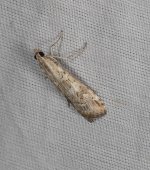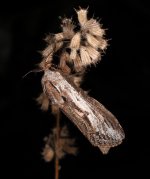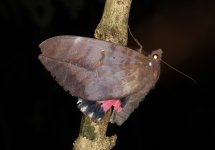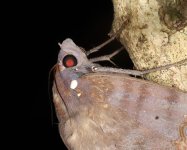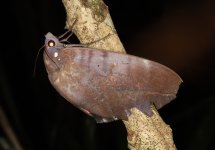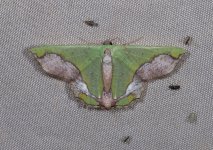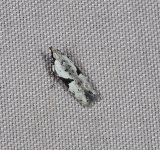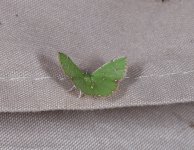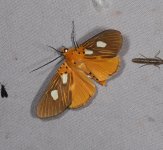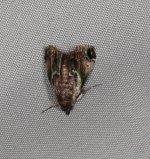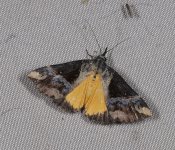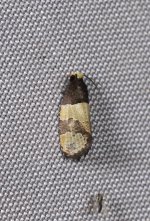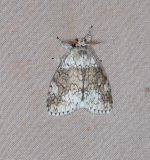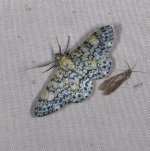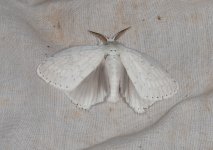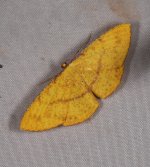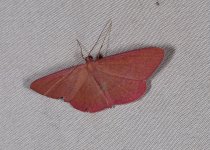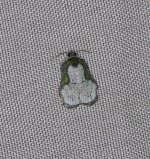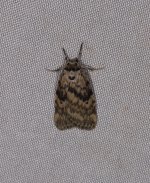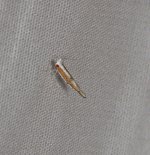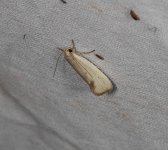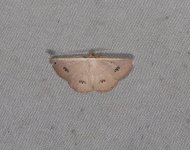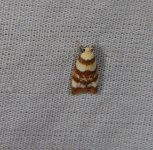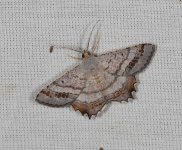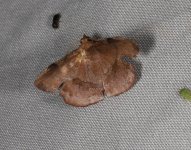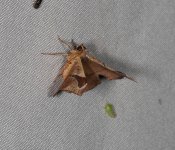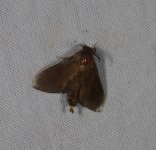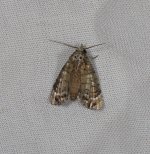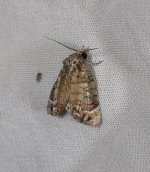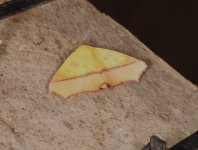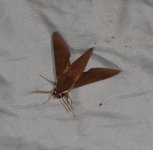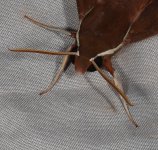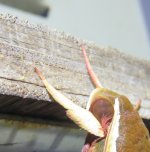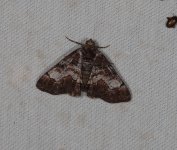-
Welcome to BirdForum, the internet's largest birding community with thousands of members from all over the world. The forums are dedicated to wild birds, birding, binoculars and equipment and all that goes with it.
Please register for an account to take part in the discussions in the forum, post your pictures in the gallery and more.
You are using an out of date browser. It may not display this or other websites correctly.
You should upgrade or use an alternative browser.
You should upgrade or use an alternative browser.
Australian Moths and other garden observations (1 Viewer)
- Thread starter Atropos
- Start date
More options
Who Replied?Have been on holiday for a few days, did take the mobile trap with me and have a few things to sort and ID but thought I would go slightly off topic though and post a few shots of some of the highlights of the trip...apologies for non moth content....have had to drastically reduce the quality to get them to load my apologies
Green Ringtail Possum
Herbert River Ringtail Possum
Lemuroid Ringtail Possum
Lesser Sooty Owl
Coppery Brushtail Possum
Yellow-bellied Glider
Green Ringtail Possum
Herbert River Ringtail Possum
Lemuroid Ringtail Possum
Lesser Sooty Owl
Coppery Brushtail Possum
Yellow-bellied Glider
Attachments
Fantastic. (Just like the moths)Have been on holiday for a few days, did take the mobile trap with me and have a few things to sort and ID but thought I would go slightly off topic though and post a few shots of some of the highlights of the trip...apologies for non moth content....have had to drastically reduce the quality to get them to load my apologies
Green Ringtail Possum
Herbert River Ringtail Possum
Lemuroid Ringtail Possum
Lesser Sooty Owl
Coppery Brushtail Possum
Yellow-bellied Glider
Last night was the first night I was able to get out and about with the genny for a while and returned to my main trap site. The Dry is often dominated by micro moths but last night there was a good mix of micro and macro species (including five species of Sphingidae). Here is a selection of the ones I have sorted so far
Aiteta pratti (Nolidae, Chloephorinae) - for a species that apparently doesn't occur here this was another very good night species with at least five buzzing around
Amerila crokeri (Erebidae, Arctiinae) - one of two species of Amerila I saw
Autoba dispar (Noctuidae, Acontiinae) - a highly variable species that is almost certainly a species complex. This is the common form
Pseudozarba orthopetes (Noctuidae, Acontiinae) - these have started to appear the last couple of weeks (saw one on holiday last month)
Catephia linteola (Erebidae, Erebinae)
Dactylioglypha tonica (Tortricidae, Olethreutinae) - a regular visitor to my sheet here on the Cape bt one that does not seem to be recorded elsewhere in Aus
Endoxyla nephocosma (Cossidae) - the large Endoxyla seem to have finished for the season, there were at least two of these on the sheet last night
Eulechria ANIC61 (Oecophoridae, Oecophorinae) - one of the commonest micro's around at the moment. Easily 30 of these on the sheet last night but mobile so hard to count
Hieromantis ephodophora (Oecophoridae, Stathmopodinae) - a small but common species, adults no more than 2-3mm in length
Myrmidonistis hoplora (Crambidae, Spilomelinae) - a regular visitor to the sheet that seems to be rarely recorded off the Cape
Opostegoides gephyraea (Opostegidae) - one of the so called "White Eyecap Moths" as the eyes are hidden behind a small white shield. At 3mm this is one of the larger members of this family, most are tiny
Termioptycha eucarta (Pyralidae, Epipaschiinae) - one of the few Epipaschiinae that are readily identifiable
Trigonocyttara (Psychidae) - as no Trigonocyttara are known from the Cape this is probably a new species for science
Aiteta pratti (Nolidae, Chloephorinae) - for a species that apparently doesn't occur here this was another very good night species with at least five buzzing around
Amerila crokeri (Erebidae, Arctiinae) - one of two species of Amerila I saw
Autoba dispar (Noctuidae, Acontiinae) - a highly variable species that is almost certainly a species complex. This is the common form
Pseudozarba orthopetes (Noctuidae, Acontiinae) - these have started to appear the last couple of weeks (saw one on holiday last month)
Catephia linteola (Erebidae, Erebinae)
Dactylioglypha tonica (Tortricidae, Olethreutinae) - a regular visitor to my sheet here on the Cape bt one that does not seem to be recorded elsewhere in Aus
Endoxyla nephocosma (Cossidae) - the large Endoxyla seem to have finished for the season, there were at least two of these on the sheet last night
Eulechria ANIC61 (Oecophoridae, Oecophorinae) - one of the commonest micro's around at the moment. Easily 30 of these on the sheet last night but mobile so hard to count
Hieromantis ephodophora (Oecophoridae, Stathmopodinae) - a small but common species, adults no more than 2-3mm in length
Myrmidonistis hoplora (Crambidae, Spilomelinae) - a regular visitor to the sheet that seems to be rarely recorded off the Cape
Opostegoides gephyraea (Opostegidae) - one of the so called "White Eyecap Moths" as the eyes are hidden behind a small white shield. At 3mm this is one of the larger members of this family, most are tiny
Termioptycha eucarta (Pyralidae, Epipaschiinae) - one of the few Epipaschiinae that are readily identifiable
Trigonocyttara (Psychidae) - as no Trigonocyttara are known from the Cape this is probably a new species for science
Attachments
-
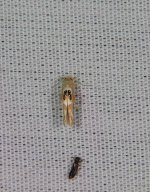 Hieromantis ephodophora.JPG551.5 KB · Views: 4
Hieromantis ephodophora.JPG551.5 KB · Views: 4 -
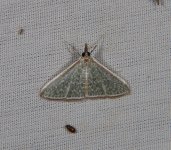 Myrmidonistis hoplora.JPG1.2 MB · Views: 4
Myrmidonistis hoplora.JPG1.2 MB · Views: 4 -
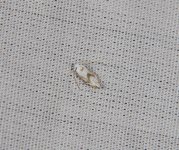 Opostegoides gephyraea.JPG1 MB · Views: 5
Opostegoides gephyraea.JPG1 MB · Views: 5 -
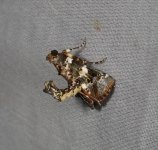 Termioptycha eucarta (2).JPG915.2 KB · Views: 5
Termioptycha eucarta (2).JPG915.2 KB · Views: 5 -
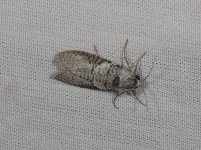 Trigonocyttara.JPG1 MB · Views: 5
Trigonocyttara.JPG1 MB · Views: 5 -
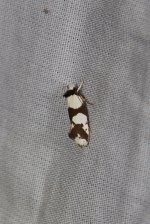 Eulechria ANIC61.JPG806.3 KB · Views: 4
Eulechria ANIC61.JPG806.3 KB · Views: 4 -
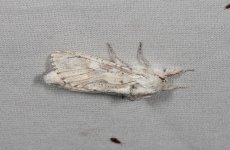 Endoxyla nephocosma.JPG1.2 MB · Views: 4
Endoxyla nephocosma.JPG1.2 MB · Views: 4 -
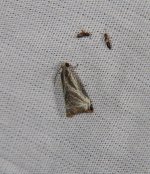 Dactylioglypha tonica.JPG810.2 KB · Views: 4
Dactylioglypha tonica.JPG810.2 KB · Views: 4 -
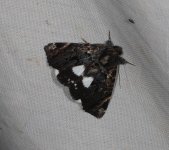 Catephia linteola.JPG2.3 MB · Views: 5
Catephia linteola.JPG2.3 MB · Views: 5 -
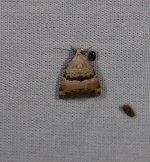 c.JPG928.7 KB · Views: 5
c.JPG928.7 KB · Views: 5 -
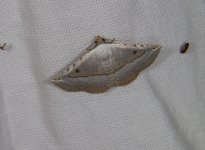 Autoba dispar.JPG1.4 MB · Views: 5
Autoba dispar.JPG1.4 MB · Views: 5 -
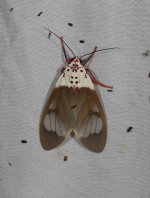 Amerila crockeri.JPG1.8 MB · Views: 4
Amerila crockeri.JPG1.8 MB · Views: 4 -
 Aiteta pratti.JPG1 MB · Views: 4
Aiteta pratti.JPG1 MB · Views: 4
Went out last night as the forecast was OK....am really starting to wonder what the point of weather forecasts are. BOM predicted 100% chance zero rain and 11kph winds....it rained hard enough that I needed my rain guard (not a problem as I love rain and am always prepared) and the so called 11kph wind blew over my trap and shattered the bulb and rain guard.....
It was looking like being a decent night as well, in the 90 minutes I had there were 6 Sphingidae of four species
Macroglossum errans - one of three
Daphnis placida
Gnathothlibus eras
Theretra oldenlandiae
It was looking like being a decent night as well, in the 90 minutes I had there were 6 Sphingidae of four species
Macroglossum errans - one of three
Daphnis placida
Gnathothlibus eras
Theretra oldenlandiae
Attachments
A much less stressful night last night. I decided to ignore the forecast and buried myself deep in the woods....of course on this occasion the forecast was pretty accurate and I would have been safe in my normal location!
Data dissimila (Noctuidae, Acronictinae) - a new species for me and I think the first record for the Cape
Endoxyla mackeri (Cossidae) - one of two that was crashing around last night
Nomophila corticalis (Crambidae, Spilomelinae) - my first for some time
Terastia subjectalis (Crambidae, Spilomelinae) - my first since 2017 and I believe the first record for the Cape
Macrotristria intersecta - my first Cicada of the season, they were very loud last night!
Data dissimila (Noctuidae, Acronictinae) - a new species for me and I think the first record for the Cape
Endoxyla mackeri (Cossidae) - one of two that was crashing around last night
Nomophila corticalis (Crambidae, Spilomelinae) - my first for some time
Terastia subjectalis (Crambidae, Spilomelinae) - my first since 2017 and I believe the first record for the Cape
Macrotristria intersecta - my first Cicada of the season, they were very loud last night!
Attachments
Technically not quite in my garden but still....went down to Cairns this week for a couple of appointments with our son and as I was binging some framed artwork back for the Hospital I drove down. Having been told that all the artwork was small (6 were one wasn't unless you count a 1.5m x 1m small) I took all my kit down and met up with a friend to go trapping for one night. Just starting to go through the photos now I am back home but one of the highlights was this Phyllodes imperialis (Erebidae, Erebinae, Catocalini) aka the Pink Underwing. With a wingspan of 17cm it is one of those species that is readily identifiable in flight. This one ignored the sheet and we eventually tracked it down on a vine not too far away.
Attachments
A few more from my recent evenings trapping in Cairns...too many for single post so will spread out over the next few days
Agathiopsis maculata (Geometridae, Geometrinae) - a female, first since 2018 and I think the first record for the Cape (certainly the first recent record - ignore this comment, I was not on the Cape when I caught this....)
Anarsia ANIC6 (Gelechiidae, Cheleriinae) - a new species for me and one of many undescribed members of this genus
Argyrocosma inductaria (Geometridae, Geometrinae) - not a common species with me
Asota australis (Erebidae, Aganianae) - only my second record of this species
Atelophleps tridesma (Erebidae, Arctiinae) - a new species for me
Agathiopsis maculata (Geometridae, Geometrinae) - a female, first since 2018 and I think the first record for the Cape (certainly the first recent record - ignore this comment, I was not on the Cape when I caught this....)
Anarsia ANIC6 (Gelechiidae, Cheleriinae) - a new species for me and one of many undescribed members of this genus
Argyrocosma inductaria (Geometridae, Geometrinae) - not a common species with me
Asota australis (Erebidae, Aganianae) - only my second record of this species
Atelophleps tridesma (Erebidae, Arctiinae) - a new species for me
Attachments
Last edited:
Second part of my recent Cairns trip
Cleora perfumosa (Geometridae, Ennominae) - I used to catch this regularly when I lived in Cairns so was very nice to reconnect and see another fresh individual
Dasychiroides pratti (Lymantrinae) - a scarce visitor
Demeijerella chrysoplea (Tortricidae, Olethreutinae) - this is I believe the first photo of a live specimen
Dichromia quinqualis (Erebidae, Hypeninae) - never a common visitor to the sheet so always nice to see, very different from the normally very brown and subdued Hypninae
Doddiana callizona (Pyralidae, Epipaschiinae) - must be a good year for this species as I have seen them in several locations.
Cleora perfumosa (Geometridae, Ennominae) - I used to catch this regularly when I lived in Cairns so was very nice to reconnect and see another fresh individual
Dasychiroides pratti (Lymantrinae) - a scarce visitor
Demeijerella chrysoplea (Tortricidae, Olethreutinae) - this is I believe the first photo of a live specimen
Dichromia quinqualis (Erebidae, Hypeninae) - never a common visitor to the sheet so always nice to see, very different from the normally very brown and subdued Hypninae
Doddiana callizona (Pyralidae, Epipaschiinae) - must be a good year for this species as I have seen them in several locations.
Attachments
Third part from my recent Cairns trip
Dura niveus (Lymantrinae) - there were several of these large moths on the sheet
Eumelea rosalia and stipata (Geometridae) - not exactly sure where these sit at the moment as various references have put them in Sterrhinae and Geometrinae but either way they are beautiful moths and a genus that I have not seen for some time
Exeristeboda exeristis (Tortricidae, Tortricanae) - a new species for me
Hectobrocha subnigra (Erebidae, Arctiinae) - this was the best marked individual out of several that appeared on the sheet
Dura niveus (Lymantrinae) - there were several of these large moths on the sheet
Eumelea rosalia and stipata (Geometridae) - not exactly sure where these sit at the moment as various references have put them in Sterrhinae and Geometrinae but either way they are beautiful moths and a genus that I have not seen for some time
Exeristeboda exeristis (Tortricidae, Tortricanae) - a new species for me
Hectobrocha subnigra (Erebidae, Arctiinae) - this was the best marked individual out of several that appeared on the sheet
Attachments
Slowly catching up on some of my ridiculous backlog of specimens to ID, particularly micros. This one is from last month and is a new family for me. This is very close to specimens labelled as Argyresthia notoleuca (Argyresthiidae) so is probably an undescribed sister species.
Attachments
Some more from my on going attempt to clear my backlog.
Casbia rhodophila (Geometridae, Ennominae) - not a particularly common species with me, I think I have caught this on less than ten occasions.
Catacometes phanozona (Oecophoridae, Oeophorinae) - a new species for me and quite a range expansion as all other published records are from SE Queensland and NSW
Oxymacaria odontias (Geometridae, Ennominae) - a variable and quite common species. It never occurs in big numbers but turns up on over 60% of nights
Casbia rhodophila (Geometridae, Ennominae) - not a particularly common species with me, I think I have caught this on less than ten occasions.
Catacometes phanozona (Oecophoridae, Oeophorinae) - a new species for me and quite a range expansion as all other published records are from SE Queensland and NSW
Oxymacaria odontias (Geometridae, Ennominae) - a variable and quite common species. It never occurs in big numbers but turns up on over 60% of nights
Attachments
First indications that the Dry season is loosing its grip tonight as there was a 30 minute period where there was steady light rain which was very encouraging (this time last year we had already had our first proper rain of the season). On the whole a typical late Dry session with micro moths predominating but there were some interesting things on the sheet. The undoubted highlight was my second west coast Fascellina (Geometridae, Ennominae). There are few published records in Australia and all of them are associated with rainforest. I got very poor photos last year as the weather was awful and I could only use my backup camera but tonight managed to get some semi decent shots with the big camera. This specimen was very small and is certainly a different undescribed species to those recorded on the east coast, was distinct compared to the ones I have seen at Kutini-Payamu in previous years.
Attachments
Just finished my first sort through from last Fridays trapping session, with 45 specimens still to ID to at least genus level the tally stands at 135 species so far which for a late Dry season is exceptional.
Was out again last night, my last night trapping before a return to work following surgery, and that was even more productive although only just started to do my initial edit.
The undoubted highlight was this Mahasena (Psychidae), this is my second example of this for 2023 (see post 373), my friend who is reviewing Australian Psychidae has confirmed that this is in fact a new species which he is in the process of formally describing. My first specimen is now designated as the holotype and the specimen from last night will be a paratype once he has confirmed it is the same species. The species has potentially serious bioseurity implications as the Asian members of this genera (in particular Mahasena corbetti) are serious leaf eating pests and are treated as "a dangerous pest" in several countries quarantine acts. The Australian specimens are a native indigenous species not as was feared initially corbetti expanding its range.
Was out again last night, my last night trapping before a return to work following surgery, and that was even more productive although only just started to do my initial edit.
The undoubted highlight was this Mahasena (Psychidae), this is my second example of this for 2023 (see post 373), my friend who is reviewing Australian Psychidae has confirmed that this is in fact a new species which he is in the process of formally describing. My first specimen is now designated as the holotype and the specimen from last night will be a paratype once he has confirmed it is the same species. The species has potentially serious bioseurity implications as the Asian members of this genera (in particular Mahasena corbetti) are serious leaf eating pests and are treated as "a dangerous pest" in several countries quarantine acts. The Australian specimens are a native indigenous species not as was feared initially corbetti expanding its range.
Attachments
Caught my second Chlumetia hampsoni (Eutelidae) last night, my first being two years ago. In Australia this species seems to be only known from three specimens caught by the late Ted Edwards in 1980 (all from the eastern side of the Cape)
Attachments
My first Xanthanomis fuscifrons (Erebidae, Erebinae, Catocalinii) for a couple of years. I caught this regularly when I was based in the NT but it is not a common moth here in FNQ with my three records from Weipa being the only state records as far as I can tell.
Attachments
Weipa is the first place that I have trapped where the majority of the Gnathothlibus hawkmoths that I can identify to species (ie the males) are Gnathothlibus australiensis. There are no reliable morphological features to seperate the females of the two Australian species and caerpillars of both species have been found on the same food plant - the caterpillars are readily separated by the absence of a blue/green halo around the abdominal eyespots in australiensis. Adult males though can be easily separated in the field by looking at the fore tarsus on front legs which are bare in australiensis and hairy in eras. The photos below are of a male Gnathothlibus australiensis from this week and in the second photo you can clearly see the bare fore tarsus.
Attachments
Pressed post on the previous entry before I meant to so will add a close up of the leg of a Gnathothlibus eras here in a separate post. You can very clearly see the hairy fore tarsus from this male I caught in 2016 compared to the same feature on the australiensis in the post above
Attachments
Work has taken over my life at the moment sadly so I am not getting out much at the moment. This is one from a couple of weeks ago Cryphaea xylina (Geometridae, Ennominae). It is only my second record (first being just north of Cairns in 2016) and as far as I can see the second record for the Cape with the only previous record being from Laura in 1977
Attachments
Similar threads
Users who are viewing this thread
Total: 2 (members: 0, guests: 2)





